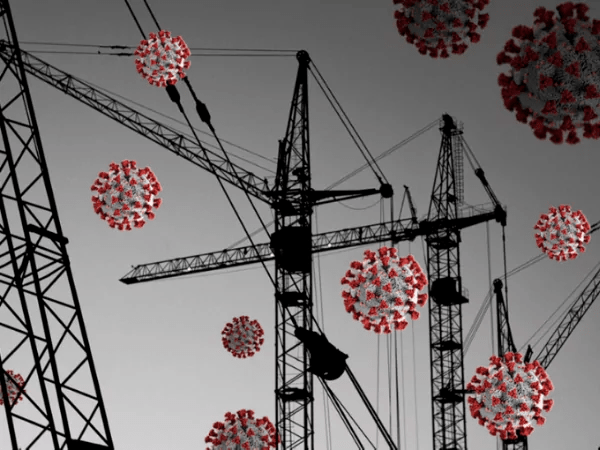5 Changes In The Near Term As Construction Activity Picks Up Across The USA
October 26, 2021

COVID-19 has resulted in a complete rehaul of day-to-day lives, impacting several activities that cannot be accomplished with the ‘remote working model. The industries that heavily depended on the frontline workforce to operate were stalled. As the curve seems to flatten, these operations are slowly reopening across the United States and are a beacon of hope to drive normalcy, employment, and economic progress.
COVID-19 and the construction industry
The construction industry is a major economic driver, employing over 11 million people in the US. The construction industry is trying to breathe life into projects that were abandoned sometime around February 2020. While the regular projects were paused, the pandemic also brought in new opportunities for the rapid construction of testing facilities, quarantining centers, and locations for medical screening.
Construction companies who were assigned a mammoth of a task to finish these projects in a very short span, of course, turned to modern tech such as BIM- Building Information Modeling. Construction companies that were earlier hesitant to embrace BIM were exposed to its benefits that can help in recovering from COVID-19’s impact on the construction business.
Several modifications to the traditional mode of operation of the construction activity are expected and it will be challenging for construction companies across the United States to bounce back.
Let’s have a look at the 5 changes coming up as construction activity picks up.
1. Managing the cash crunch
As per a survey by PwC, 71% of participants belonging to the engineering and construction sector expressed financial concern as the biggest impact of COVID-19. Needless to say, cash flow will be one of the major constraints for construction companies. As per a report by the World Economic Forum, the construction sector in the USA hasn’t still leveraged technology to its fullest. To manage constrained finances now is the time to make use of the power of technologies like BIM. BIM can help in accurately estimating material demands to ensure you don’t lock unnecessary funds in wasted materials. Further, BIM can help you in planning your labor resources and optimize costs.
2. Addressing the construction material shortage
While we are discussing the issue of raw materials, we have to account for the possible shortage of the same. The USA imports around 30% of its total raw material required for construction from China, with some companies fetching around 80% of their requirement from those shores. Following the shutdown of Chinese manufacturing units, there has been a shortage of material. The current complicated trade scenario isn’t likely to allow an easing up of those supply chains soon.With BIM, companies can estimate their raw material requirement better, make judicious usage, and plan ahead for orders and be ready whenever the supply chains open up as usual.
3. Providing a safe working environment and revision of labor contracts
Workplace operations have drastically changed. There are new rules for managing employees to ensure social distancing. Emergency protocols were already in place a few weeks before the outbreak but post the re-opening, there will be severe implications. Without the complete opening of public transports, lifting of travel bans, and opening up of schools and other child-care facilities, workers might not be able to return to work immediately in full force. And even if they do, they have to be rostered in shifts which means that resource planning will become critical. Companies have to focus on accomplishing the same (or better) results with fewer employees in the near future.
This calls for a revision in labor plans as well as enhanced resource optimization using Building Information Modeling for timely project completion. Using BIM’s fundamental benefit of clash detection, companies can ensure improved work efficiency with minimum rework, better staff utilization, and lowered costs. Off-site experts and remote working partners can be of great help.
4. Data-driven decision making for prioritizing projects
Construction companies have to balance between completing the pending projects while controlling their cash outflow. Construction projects require strict adherence to schedules for completion often incurring financial penalties for delays. BIM can be valuable in planning and scheduling workflows to optimize delivery times while making the use of available resources to their full potential. The use of Building Information Modeling can aid in overall project delivery planning with efficient communication, collaboration, and constant monitoring of the project’s progress. This could be a crucial help in making up for a lost time.
But it is important to note that adopting any tech, especially on a large scale is challenging. This calls for expertise and may require changes to established processes and workflows. Seeking the help of a trusted domain expert who can partner in the adoption is hence recommended for getting the required ROI.
5. Preference for green buildings and construction
The construction sector is infamous for contributing to the global climate crisis, being responsible for around 40% of the total CO2 emissions. The post-pandemic world will be more conscious about the choices it makes- be it for food, fashion, or energy consumption. The construction industry has already been seeing a rising demand for driving more energy-efficient projects, creating less waste, and opting for green or eco-friendly construction materials. Using BIM, construction companies can take important steps in implementing the same phase-wise, with optimum resource planning. By participating in the Green construction movement and creating zero-emission buildings, the construction sector can gain financial green stimulus packages helping in economic recovery while giving back to the environment.
To summarize…
The world post-COVID-19 will not be the same. To sail through difficult times, riding the wave of technology may be the key. And with the right BIM partner, construction companies can define their way into a stable future.















